Anti-tank capabilities of British aviation during the Second World War
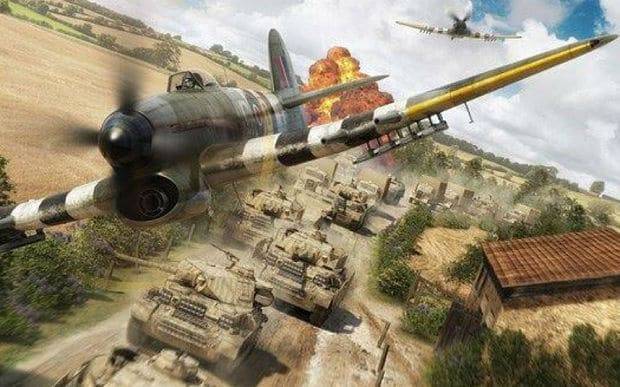
In the initial period of the Second World War in Great Britain there were no specialized combat aircraft designed to deal with enemy armored vehicles. In 1940–1942 during the fighting in France and North Africa, the British tried to use against the German tanks available fighters and light bombers.
The effectiveness of such airstrikes was very low. Fighters armed with rifle-caliber machine guns were absolutely powerless against tanks, and Hurricane Mk IIC aircraft with 20 mm Hispano Mk II cannons could pose a threat only to light armored vehicles. But even when penetrating the bulletproof armor of tankettes and armored vehicles, the armor effect of 20-mm shells was weak.
Things were no better with the actions of the bomber aviation. The main British light twin-engine bomber of the period 1941-1942. The Blenheim Mk I was not suitable for diving, and bombing was carried out in level flight from a height of 500–1 m. On average, a Blenheim squadron, when each aircraft carried four 000-kg high explosive bombs, could destroy or seriously damage 113–1 enemy tank. Due to the absence of bombs with special fuses and braking devices, the British did not bomb from low altitudes. The best results, quite predictably, were achieved when striking at places of accumulation of tanks and columns of armored vehicles. Tanks deployed in battle formations were less vulnerable to bombers.
Attack aircraft and fighter-bombers based on the Hawker Hurricane II fighter
In the second half of 1941, it became clear that without exception, all modifications of the British Hawker Hurricane II fighter were outdated and could not fight on equal terms with the German Messerschmitt Bf 109F and the Italian Macchi C.202 Folgore. In this regard, the Hurricanes available in North Africa began to be used as fighter-bombers and attack aircraft.
For a confident defeat of medium tanks, weapons were required that were more powerful than 20-mm guns, and on the basis of the Hurricane IIB Trop fighter, the shock Hurricane IID was created, armed with two 40-mm Vickers Class S (Vickers S) guns.
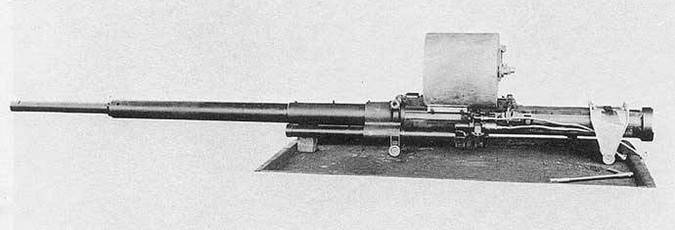
40-mm aircraft gun Vickers S
This large-caliber gun by aviation standards weighed 134 kg. A 40 mm armor-piercing projectile weighing 1 g left a 113 m long gun barrel at a speed of 1,7 m/s and pierced a 570 mm armor plate at a distance of 300 m.

40 mm armor-piercing projectile
Theoretically, such an indicator of armor penetration made it possible to confidently deal with medium German tanks when fired on the side or from the stern. The rate of fire was 100 rds / min.
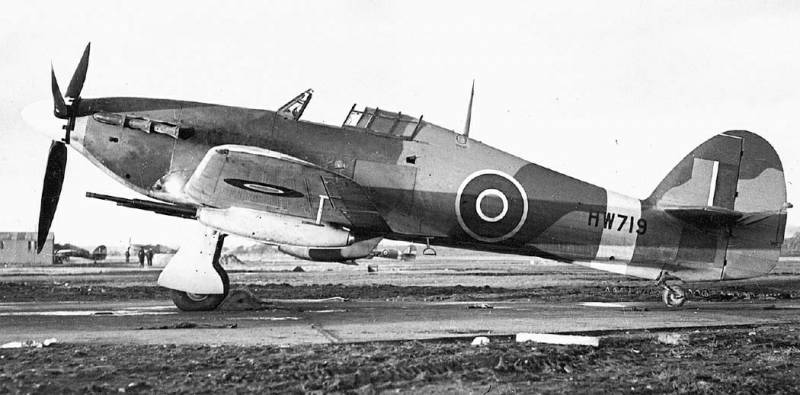
Hurricane IID tank destroyer
Since the "artillery" fighter had to mainly operate near the ground, the cockpit and a number of the most vulnerable places of the aircraft were partially covered with armor to protect against anti-aircraft fire. The weight of two 40-mm guns with 15 rounds of ammunition per barrel was about 370 kg. Armor protection and large-sized 40-mm guns further worsened the already not very high flight data of the Hurricane. Heavy artillery mounts reduced the maximum speed by 64 km/h, which made anti-tank aircraft easy prey for the Messerschmits.
The first unit to use artillery "Hurricanes" in battle was the 6th squadron. On a sortie on 7 July 1942, the Hurricane Mk. The IID destroyed two tanks, as well as several tractors and trucks.
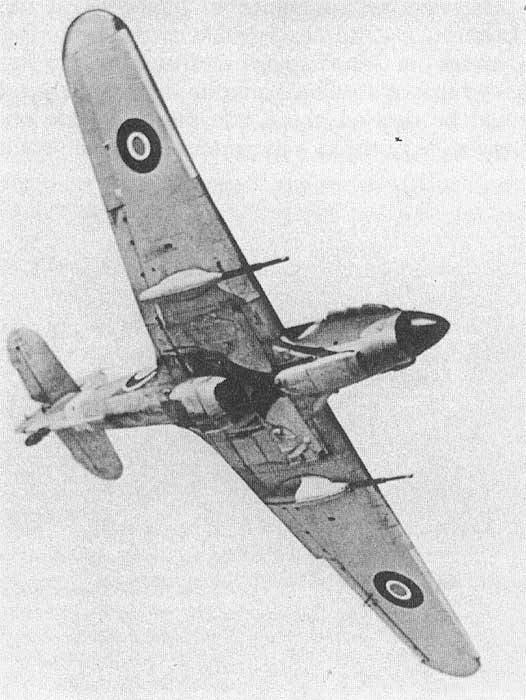
According to the results of combat use, it was noted that for the successful use of 40-mm guns, the pilot must have a high level of training. The ammunition load of shells available on board made it possible to make 2-3 combat approaches to the target. Aimed shooting due to strong recoil was possible with the first 2–3 shots.
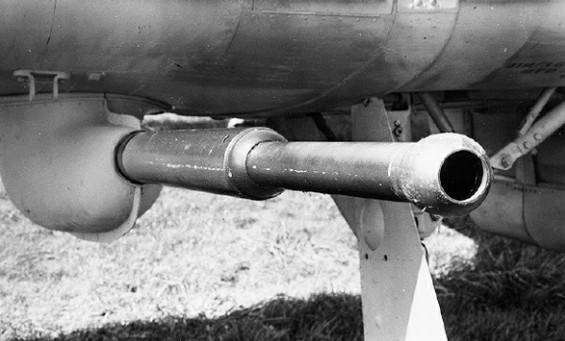
Fire on a single tank was opened from a distance of no more than 500 m. Before firing from cannons, it was recommended to zero in with tracer bullets from two 7,7 mm Browning .303 Mk II machine guns, but even in this case, as a rule, it was possible to hit the target 1-2 projectiles. When hitting a tank, due to the high angles of the shell's encounter with the armor, penetration did not always occur. And when the shell still pierced the armor, this did not mean the destruction or the long-term failure of the tank.
However, Hurricane Mk. IIDs were used quite actively. According to British data, during the five-day battle of El Alamein, which began on the evening of October 23, 1942, "Hurricanes" with 40-mm guns during 842 sorties destroyed 39 tanks, more than 200 armored personnel carriers and trucks, 26 fuel tanks and 42 artillery tools. Own losses in equipment were not disclosed, but it is known that 11 British pilots were killed during the assault airstrikes.
Following the Hurricane IID came the Hurricane IIE. After the release of 290 machines, due to a large number of changes, the aircraft was renamed the Hurricane IV. A total of 524 attack aircraft of this modification were manufactured.
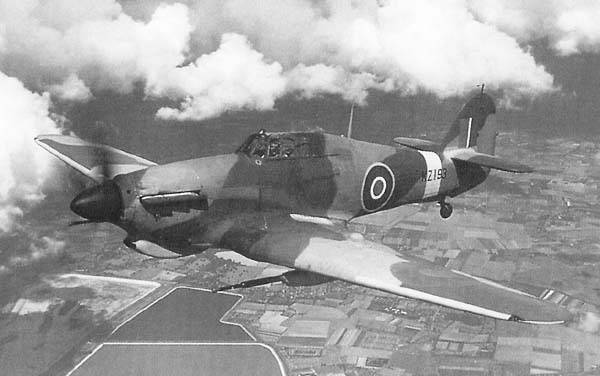
Hurricane IV
In order to reduce vulnerability to shelling from the ground, the armor was further strengthened. Now not only the cabin and the radiator were protected, but the armor also appeared on the sides of the engine. On this aircraft, 40-mm guns were placed in removable gondolas. Instead, eight 60-pound RP-3 rockets could be suspended.
Built-in armament consisted of two 7,7 mm Browning .303 Mk II machine guns. Instead of guns and missiles, the aircraft could carry two external fuel tanks or two 113-kg bombs. It was not possible to use cannons and rockets under different wings, because due to the strong recoil when firing from a cannon, the rockets fell off the rails, and the plane itself turned around strongly.
To compensate for the drop in flight data due to the increased takeoff weight, a Merlin 27 engine with an 1 horsepower was installed on the Hurricane IV. With. The aircraft with a maximum takeoff weight of 620 kg had a practical flight range of 3 km. When installing two external fuel tanks with a total capacity of 840 liters, the flight range increased to 640 km. The maximum speed was 400 km / h, cruising - 1 km / h.
Despite the low flight data, mass production of "artillery" Hurricanes continued until the beginning of 1944. Pilots flying in North Africa on planes armed with 40-mm cannons claimed the destruction of 47 tanks and about 200 pieces of other equipment. Since June 1943, "artillery" attack aircraft began to operate in Europe. If armored vehicles were the main targets in Africa, then in Europe they mainly hunted for steam locomotives, and also destroyed the starting positions of German missiles that terrorized large British cities.
In early 1944, attack aircraft were used against the Japanese in Burma. Since there were relatively few tanks in the Japanese army, artillery attack aircraft, using mainly fragmentation 40-mm shells, operated on transport communications and sank small ships in the coastal zone. In sorties from 700 Hurricanes with 40-mm guns, about a third was lost.
Based on the 40 mm Vickers S gun, it was planned to create a 57 mm aircraft gun with armor penetration up to 100 mm, but calculations showed that such an artillery system would have excessive mass and unacceptably strong recoil for use on single-engine fighters, and work in this direction was curtailed.
It is known that instead of 40-mm cannons, two 113-kg bombs could be hung on the Hurricane strike. After dropping the bombs, the aircraft became much more maneuverable and could reach higher speeds than with large-caliber guns. However, the bombing accuracy of the Hurricane IV was not very high, and aircraft bombs were not often dropped on tanks from this aircraft.
The use of 40-mm guns against ground targets did not arouse much enthusiasm among British pilots, and rockets became the main anti-tank weapon. For the first time, the British used armor-piercing aircraft missiles in June 1942.
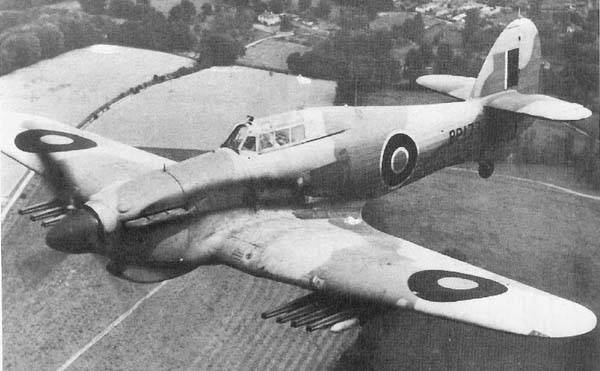
The British aviation rocket RP-3 was created on the basis of a 76,2-mm unguided anti-aircraft missile. The three-inch anti-aircraft missile was a simple tubular structure with stabilizers, the engine used a 5-kg charge of SCRK brand cordite. Initially, aviation rockets were intended for firing at submarines at periscope depth or on the surface, and had an armor-piercing warhead in the form of a steel blank, but subsequently several different warheads were developed, screwing on a three-inch pipe with stabilizers.
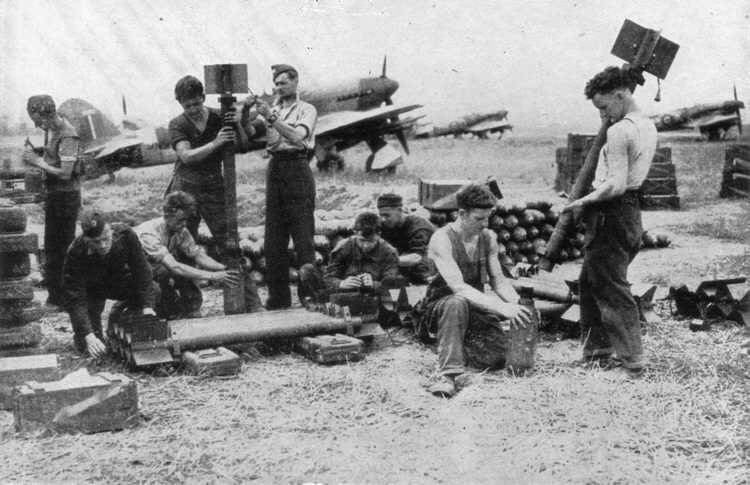
Preparation for the combat use of RP-3 missiles
A missile with an armor-piercing 25-pound (11,35 kg) solid blank of 3,44-inch (87,3 mm) caliber, accelerating to 430 m / s, pierced 700-mm armor at a distance of 76 meters along the normal. The launch of missiles at enemy tanks was usually carried out at a distance of 300-400 meters. The damaging effect, in the event of penetration, was intensified by the cordite of the main engine that continued to burn.
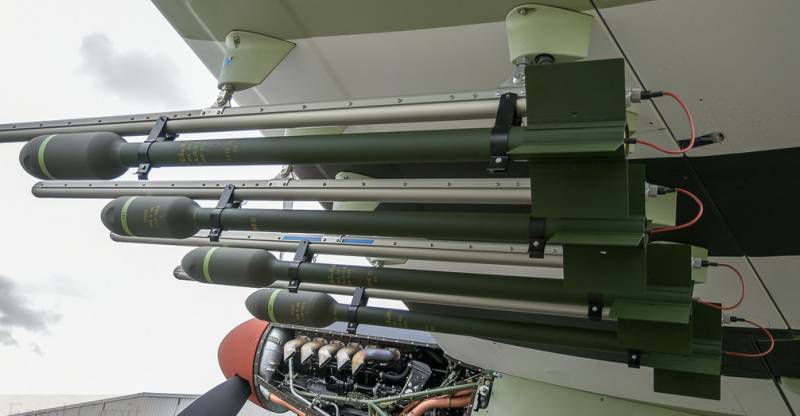
There was also a high-explosive 60-pound rocket, its real weight, despite the designation, was 47 pounds or 21,31 kg. The 4,5-inch (114 mm) high-explosive fragmentation warhead did not penetrate the frontal armor of a medium German tank, but was able to break through 30 mm side armor. In the event that 1,36 kg of an alloy of TNT and RDX got into the undercarriage of an armored vehicle, it turned out to be enough to immobilize the combat vehicle. Undermining the warhead on the armor of the tank, as a rule, did not pass without a trace. Even if the armor survived, observation devices and sights often suffered, attachments were swept away, the turret jammed, the gun and chassis were damaged. In most cases, tanks that were hit by high-explosive fragmentation missiles lost their combat effectiveness.
Rockets RP-3 showed good results when attacking columns and suppressing anti-aircraft batteries, attacking airfields and trains. The probability of a single missile hitting a tank was low, this was partly offset by a salvo launch. In June 1942, aircraft missiles began to be actively used by British fighter-bombers in North Africa. According to the reports of British pilots, with a salvo launch of missiles on a single tank, it was possible to achieve hits in 5% of cases. Due to the low accuracy, when it was possible, they tried to carry out NAR launches in places of accumulation and columns of armored vehicles.
Also known are rockets with 114-mm warheads equipped with white phosphorus. However, in most cases they were not effective against tanks. When hit on the armor, white phosphorus burned out without causing much harm to combat vehicles. Incendiary shells posed a threat to trucks or armored personnel carriers open on top, tractors, tanks with open hatches during loading of ammunition or refueling.
In connection with the increase in the security of German tanks in 1943, the NAR was adopted by the NAR with a 152-mm armor-piercing high-explosive warhead, weighing 27,3 kg, containing 5,45 kg of explosives. The rocket engine remained the same, but the mass and drag increased significantly, the maximum flight speed dropped to 350 m/s. For this reason, accuracy deteriorated somewhat and the effective firing range decreased, which was partly offset by an increased damaging effect.

152mm 60lb SAP No2 Mk. I
It is believed that such missiles were effective even against heavy Tigers. If hitting a heavy tank did not lead to armor penetration, it still received heavy damage, the crew and internal units were often affected by internal armor chips. Thanks to the powerful warhead, with a close gap, the chassis was destroyed, optics and weapons were knocked out. At a distance of 3 meters, heavy fragments could penetrate a 12-mm armor plate.
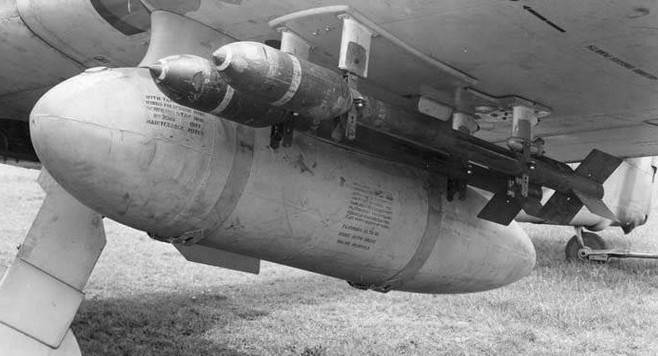
Heavy 152-mm rockets were successfully used from various carrier aircraft against ships, trains, military columns and artillery positions. There were cases when a rocket salvo from a British attack aircraft destroyed small bridges, which prevented the advance of German armored vehicles.
The effectiveness of the use of missiles directly depended on the qualifications and experience of the pilot. Usually, during the attack, British attack aircraft swooped down on the target at an angle of up to 45 °. The steeper the dive angle, the greater was the launch accuracy of the NAR. After the target hit the sight grid, immediately before the launch, it was necessary to slightly raise the nose of the aircraft in order to take into account the downward drop of the missiles. For inexperienced pilots, a recommendation was issued to zero in with tracer bullets before launching missiles.
Hawker Typhoon fighter-bombers
By the time missiles with 152-mm armor-piercing high-explosive warheads were adopted, fighter-bombers and Hurricane IV attack aircraft began to leave the scene. By that time, the Typhoon, put into mass production in 1941, had become the main British tactical strike aircraft. Initially, the Typhoon was developed as an interceptor, but did not achieve success in this role. But after the elimination of childhood diseases, he was very successful as a shock machine. Typhoon fighter-bombers made their first sorties against ground targets in November 1942. Although there was no powerful armor protection on board, aircraft of later versions demonstrated good survivability.
The Typhoon IB fighter-bomber had a maximum takeoff weight of 6341 kg. Napier Saber IIC liquid-cooled engine with 2260 hp. With. without suspensions on external nodes, near the ground it provided speeds up to 660 km / h. The high flight speed made it possible to escape from German interceptors.
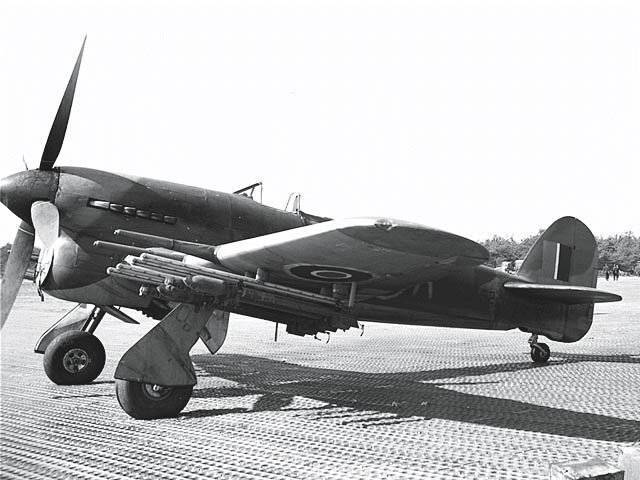
Typhoon fighter-bomber
The Typhoon's success as a fighter-bomber was facilitated by good controllability at low altitudes and powerful armament: four 20-mm cannons, eight NARs, two 227- or 454-kg bombs. The practical flight range with heavy missiles was 740 km. The practical range with 227-kg bombs is 820 km.
At the end of 1943, the RAF Second Tactical Command was formed from 18 air units of the Typhoons, the main task of which was to provide direct air support to ground forces, to combat enemy fortifications and armored vehicles.
Basically, British fighter-bombers acted on enemy communications. It was much easier to fight columns of German tanks moving along narrow European roads than to destroy them one by one on the battlefield.
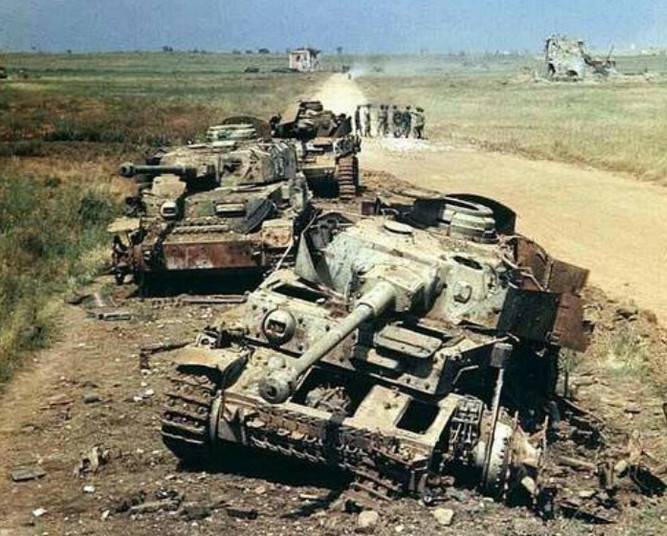
Theoretically, on any British Typhoon, depending on the nature of the intended target, the bomb racks could be replaced by missile guides, but in practice, in each squadron, some of the aircraft constantly had bomb racks, and some had NAR guides.
As a rule, when striking with large forces, British attack aircraft carried various means of destruction. Some of the planes were armed with missiles, while the other part carried bombs. The first to attack in this case were fighter-bombers with missiles. They stopped the column, striking at its head, and suppressed anti-aircraft opposition.
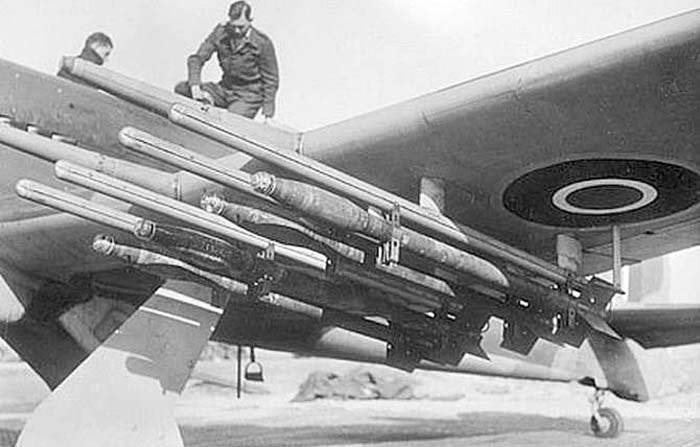
60-pound high-explosive rockets under the wing of a Typhoon fighter-bomber
Squadrons specialized in missile attacks were equipped with the most experienced pilots, and German armored vehicles were among the highest priority targets. So, according to British sources, on August 7, 1944, Typhoon fighter-bombers launched rocket attacks on German tank units moving towards Normandy during the day, while the pilots announced the destruction of 84 and damage to 56 tanks. However, later the British command found out that only 12 tanks and self-propelled guns were badly damaged and destroyed by missiles. However, among the burnt and wrecked tanks there were many armored personnel carriers and tracked tractors, which in the heat of battle could be mistaken for tanks or self-propelled guns.
Very often, enemy losses were greatly inflated. According to the results of several detailed investigations carried out to determine the combat effectiveness of British fighter-bombers, it was found that real achievements did not exceed 10-15% of the declared number of enemy tanks destroyed and permanently disabled. In fairness, it should be said that it is difficult to objectively assess the degree of damage to an enemy tank or self-propelled guns after a NAR hit or a close explosion of an aerial bomb in most cases, and pilots were often overly optimistic.
Hawker Tempest fighter-bombers
In April 1944, the Tempest fighter (originally named Typhoon II) was adopted. This aircraft was a further development of the attack "Typhoon" and at the end of the war pushed it into the attack squadrons of the RAF. The main difference from the previous model was the wing, which had a laminar profile, which made it possible to increase the flight speed.
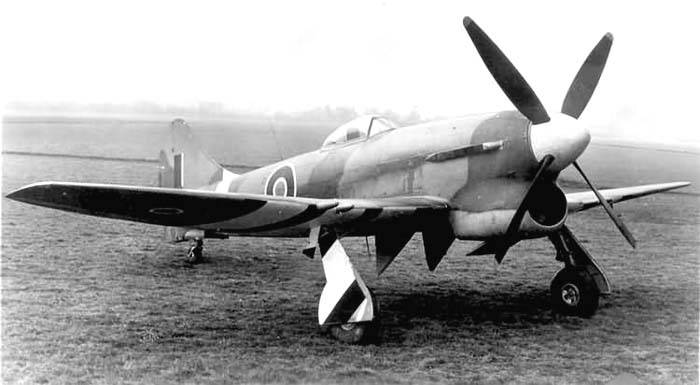
Tempest Mk.V
Aircraft modified Tempest Mk. V with a maximum takeoff weight of 6 kg was equipped with a Napier Saber IIA engine with an HP 187 power. With. The maximum flight speed is up to 2 km / h. Practical range - 180 km. The built-in armament remained the same as on the Typhoon, but the ammunition load for four 686-mm guns increased to 1 shells (on the Typhoon 190 shells per gun). Under the plane it was possible to hang 20 missiles, two 800-kg or four 140-kg bombs.
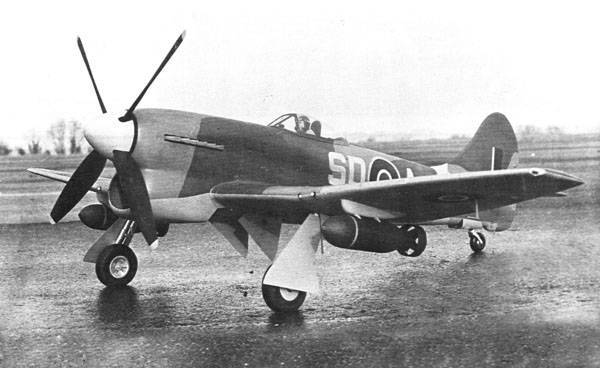
The flight data of the Tempest made it possible to successfully conduct air combat with any serial German piston fighter, and it was very good as an interceptor. Due to its powerful armament and long range, the Tempest was also used for strike missions, albeit on a smaller scale than the Typhoon.
The experience of using 40-mm guns on the Hurricanes, it would seem, should have closed this topic, but after the first encounter with the Tigers in North Africa, the RAF command ordered an aircraft gun from Vickers, capable of penetrating the armor of heavy tanks.
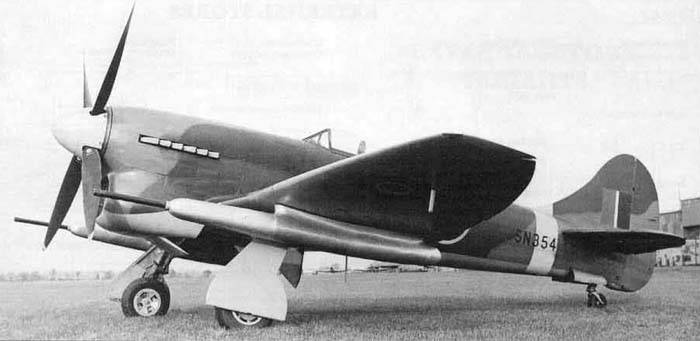
Tempest Mk. V with 47 mm Vickers P guns
The 47 mm Vickers Class P (Vickers P) gun weighed about 270 kg. Ammunition for this caliber was decent and reached 30 shots per barrel. The rate of fire was 60-70 rds / min. Armor-piercing projectile weighing 2,07 kg, fired at a speed of 808 m / s, was supposed to penetrate 75-mm armor. When using a tungsten carbide core in a projectile, the value of armor penetration was supposed to be increased to 100 mm.
The refinement of the 47-mm aircraft gun was completed after the end of the war. In early 1946, the Tempest Mk. V with a pair of 47 mm guns. In general, the guns and the fighter showed themselves not badly. However, due to the loss of relevance, the project was closed.
To be continued ...
Information